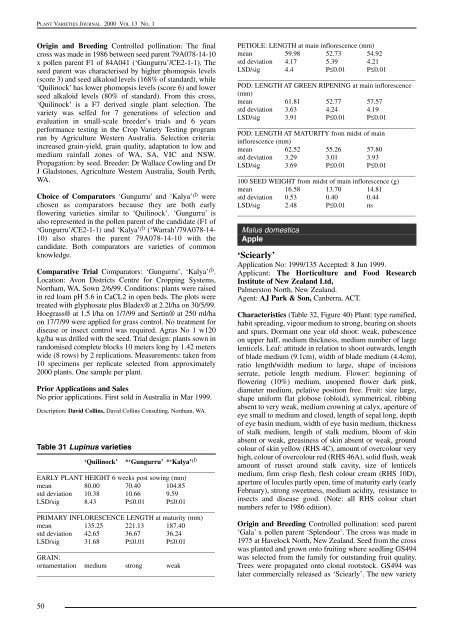53. Volume 13- Number 1 - IP Australia
53. Volume 13- Number 1 - IP Australia
53. Volume 13- Number 1 - IP Australia
Create successful ePaper yourself
Turn your PDF publications into a flip-book with our unique Google optimized e-Paper software.
PLANT VARIETIES JOURNAL 2000 VOL <strong>13</strong> NO. 1<br />
Origin and Breeding Controlled pollination: The final<br />
cross was made in 1986 between seed parent 79A078-14-10<br />
x pollen parent F1 of 84A041 (‘Gungurru’/CE2-1-1). The<br />
seed parent was characterised by higher phomopsis levels<br />
(score 3) and seed alkaloid levels (168% of standard), while<br />
‘Quilinock’ has lower phomopsis levels (score 6) and lower<br />
seed alkaloid levels (80% of standard). From this cross,<br />
‘Quilinock’ is a F7 derived single plant selection. The<br />
variety was selfed for 7 generations of selection and<br />
evaluation in small-scale breeder’s trials and 6 years<br />
performance testing in the Crop Variety Testing program<br />
run by Agriculture Western <strong>Australia</strong>. Selection criteria:<br />
increased grain-yield, grain quality, adaptation to low and<br />
medium rainfall zones of WA, SA, VIC and NSW.<br />
Propagation: by seed. Breeder: Dr Wallace Cowling and Dr<br />
J Gladstones, Agriculture Western <strong>Australia</strong>, South Perth,<br />
WA.<br />
Choice of Comparators ‘Gungurru’ and ‘Kalya’ A were<br />
chosen as comparators because they are both early<br />
flowering varieties similar to ‘Quilinock’. ‘Gungurru’ is<br />
also represented in the pollen parent of the candidate (F1 of<br />
‘Gungurru’/CE2-1-1) and ‘Kalya’ A (‘Warrah’/79A078-14-<br />
10) also shares the parent 79A078-14-10 with the<br />
candidate. Both comparators are varieties of common<br />
knowledge.<br />
Comparative Trial Comparators: ‘Gungurru’, ‘Kalya’ A .<br />
Location: Avon Districts Centre for Cropping Systems,<br />
Northam, WA. Sown 2/6/99. Conditions: plants were raised<br />
in red loam pH 5.6 in CaCL2 in open beds. The plots were<br />
treated with glyphosate plus Bladex® at 2.2l/ha on 30/5/99.<br />
Hoegrass® at 1.5 l/ha on 1/7/99 and Sertin® at 250 ml/ha<br />
on 17/7/99 were applied for grass control. No treatment for<br />
disease or insect control was required. Agras No 1 w120<br />
kg/ha was drilled with the seed. Trial design: plants sown in<br />
randomised complete blocks 10 meters long by 1.42 meters<br />
wide (8 rows) by 2 replications. Measurements: taken from<br />
10 specimens per replicate selected from approximately<br />
2000 plants. One sample per plant.<br />
Prior Applications and Sales<br />
No prior applications. First sold in <strong>Australia</strong> in Mar 1999.<br />
Description: David Collins, David Collins Consulting, Northam, WA.<br />
Table 31 Lupinus varieties<br />
‘Quilinock’ *‘Gungurru’ *‘Kalya’ A<br />
____________________________________________________<br />
EARLY PLANT HEIGHT 6 weeks post sowing (mm)<br />
mean 80.00 70.40 104.85<br />
std deviation 10.38 10.66 9.59<br />
LSD/sig 8.43 P≤0.01 P≤0.01<br />
____________________________________________________<br />
PRIMARY INFLORESCENCE LENGTH at maturity (mm)<br />
mean <strong>13</strong>5.25 221.<strong>13</strong> 187.40<br />
std deviation 42.65 36.67 36.24<br />
LSD/sig 31.68 P≤0.01 P≤0.01<br />
____________________________________________________<br />
GRAIN:<br />
ornamentation medium strong weak<br />
____________________________________________________<br />
PETIOLE: LENGTH at main inflorescence (mm)<br />
mean 59.98 52.73 54.92<br />
std deviation 4.17 5.39 4.21<br />
LSD/sig 4.4 P≤0.01 P≤0.01<br />
____________________________________________________<br />
POD: LENGTH AT GREEN R<strong>IP</strong>ENING at main inflorescence<br />
(mm)<br />
mean 61.81 52.77 57.57<br />
std deviation 3.63 4.24 4.19<br />
LSD/sig 3.91 P≤0.01 P≤0.01<br />
____________________________________________________<br />
POD: LENGTH AT MATURITY from midst of main<br />
inflorescence (mm)<br />
mean 62.52 55.26 57.80<br />
std deviation 3.29 3.01 3.93<br />
LSD/sig 3.69 P≤0.01 P≤0.01<br />
____________________________________________________<br />
100 SEED WEIGHT from midst of main inflorescence (g)<br />
mean 16.58 <strong>13</strong>.70 14.81<br />
std deviation 0.53 0.40 0.44<br />
LSD/sig 2.48 P≤0.01 ns<br />
____________________________________________________<br />
Malus domestica<br />
Apple<br />
‘Sciearly’<br />
Application No: 1999/<strong>13</strong>5 Accepted: 8 Jun 1999.<br />
Applicant: The Horticulture and Food Research<br />
Institute of New Zealand Ltd,<br />
Palmerston North, New Zealand.<br />
Agent: AJ Park & Son, Canberra, ACT.<br />
Characteristics (Table 32, Figure 40) Plant: type ramified,<br />
habit spreading, vigour medium to strong, bearing on shoots<br />
and spurs. Dormant one year old shoot: weak, pubescence<br />
on upper half, medium thickness, medium number of large<br />
lenticels. Leaf: attitude in relation to shoot outwards, length<br />
of blade medium (9.1cm), width of blade medium (4.4cm),<br />
ratio length/width medium to large, shape of incisions<br />
serrate, petiole length medium. Flower: beginning of<br />
flowering (10%) medium, unopened flower dark pink,<br />
diameter medium, pelative position free. Fruit: size large,<br />
shape uniform flat globose (obloid), symmetrical, ribbing<br />
absent to very weak, medium crowning at calyx, aperture of<br />
eye small to medium and closed, length of sepal long, depth<br />
of eye basin medium, width of eye basin medium, thickness<br />
of stalk medium, length of stalk medium, bloom of skin<br />
absent or weak, greasiness of skin absent or weak, ground<br />
colour of skin yellow (RHS 4C), amount of overcolour very<br />
high, colour of overcolour red (RHS 46A), solid flush, weak<br />
amount of russet around stalk cavity, size of lenticels<br />
medium, firm crisp flesh, flesh colour cream (RHS 10D),<br />
aperture of locules partly open, time of maturity early (early<br />
February), strong sweetness, medium acidity, resistance to<br />
insects and disease good. (Note: all RHS colour chart<br />
numbers refer to 1986 edition).<br />
Origin and Breeding Controlled pollination: seed parent<br />
‘Gala’ x pollen parent ‘Splendour’. The cross was made in<br />
1975 at Havelock North, New Zealand. Seed from the cross<br />
was planted and grown onto fruiting where seedling GS494<br />
was selected from the family for outstanding fruit quality.<br />
Trees were propagated onto clonal rootstock. GS494 was<br />
later commercially released as ‘Sciearly’. The new variety<br />
50

















